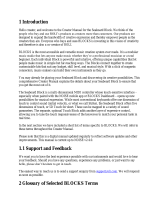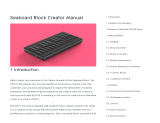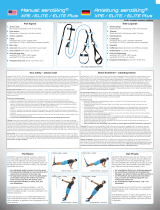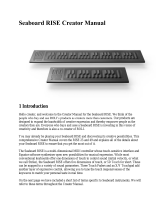Page is loading ...

2 Elite 9 Installation Guide, Rev. B
Contents
Preface .................................................................. 1
Electrostatic discharge protection........................... 1
Important safety information and precautions ......... 2
Wichtige Sicherheitshinweise ............................... 5
Technical support services..................................... 10
General description ................................................ 12
Initial setup information........................................... 18
Kühlung des Systems .......................................... 29
Installation des Laufwerkes
und Anschluß der Kabel....................................... 32
© 1994 Seagate Technology, Inc. All rights reserved
Publication Number: 83328850, Rev. B
October 1994
Seagate
®
, Seagate Technology
®
, and the Seagate logo
are registered trademarks of Seagate Technology, Inc.
Elite™, SeaFAX™, SeaFONE™, SeaTDD™, and
SeaBOARD™ are trademarks of Seagate Technology,
Inc. Other product names are registered trademarks or
trademarks of their owners.
No part of this publication may be reproduced in any
form without written permission from Seagate Tech-
nology, Inc.

Elite 9 Installation Guide, Rev. B 1
Preface
This manual contains information for users of Seagate
®
Elite™ 9 SCSI disc drives. It provides support services,
performance specifications, and initial setup informa-
tion. Additional information is available in the
Elite 9
Product Manual
(part number 83328860). Contact your
Seagate sales representative if you need to order this
publication.
Electrostatic discharge protection
Caution. Removal of circuit boards by personnel not
performing depot repair will damage com-
ponents and may void the warranty.
All drive electronic assemblies are sensitive to static
electricity, due to the electrostatically sensitive devices
used within the drive circuitry. Although some devices
such as metal-oxide semiconductors are extremely
sensitive, all semiconductors, as well as some resistors
and capacitors, may be damaged or degraded by expo-
sure to static electricity.
Electrostatic damage to electronic devices may be
caused by the direct discharge of a charged conductor
or by exposure to the static fields surrounding charged
objects. To avoid damaging drive electronic assemblies,
observe the following precautions when installing or
servicing the drive:

2 Elite 9 Installation Guide, Rev. B
• Ground yourself to the drive whenever the drive elec-
tronics are or will be exposed. Connect yourself to
ground with a wrist strap (Seagate part number
12263496). Connection may be made to any grounded
metal assembly. As a general rule, remember that you
and the drive electronics must all be grounded to avoid
potentially damaging static discharges.
• Turn off the power before removing or installing the DC
power cable.
• Do not remove any circuit boards from the drive.
• Never use an ohmmeter on any circuit boards.
Important safety information and precautions
Caution. Use forced-air ventilation when bench-testing
the drive to ensure proper cooling of drive
components.
Use proper safety and repair techniques for safe, reliable
operation of this unit. Service should be done only by
qualified persons. We recommend the procedures in this
manual as effective ways of servicing the unit. Some
procedures require the use of special tools. For proper
maintenance and safety, you must use these tools as
recommended.
The procedures in this manual and labels on the unit
contain warnings and cautions that must be carefully

Elite 9 Installation Guide, Rev. B 3
read and followed to minimize or eliminate the risk of
personal injury. The warnings point out conditions or
practices that may endanger you or others. The cautions
point out conditions or practices that may damage the
unit, possibly making it unsafe for use.
These warnings and cautions are not exhaustive. We
cannot possibly know, evaluate, and advise you of all the
ways in which maintenance might be performed or the
possible risk of each technique. Consequently, we have
not completed any such broad evaluation. If you use a
non-approved procedure or tool, first ensure that the
method you choose will not risk either your safety or unit
performance.
Always observe the following warnings and precautions:
• Perform all maintenance by following the procedures in
this manual.
• Follow all cautions and warnings in the procedures.
• Use sound safety practices when operating or repair-
ing the unit.
• Use caution when troubleshooting a unit that has
voltages present. Turn off power to the unit before
servicing it.
• Wear safety shoes when removing or replacing heavy
parts.

4 Elite 9 Installation Guide, Rev. B
• Ensure that the internal temperature of the rack or
cabinet does not exceed the limits defined for the drive
when the drive is mounted in an equipment rack or
cabinet. When units are stacked vertically, pay atten-
tion to the top where temperatures are usually highest.
• Follow the precautions listed above in “Electrostatic
discharge protection.”
• Do not remove any circuit boards from the drive chas-
sis. Return the entire drive for depot repair if any circuit
board is defective. Removal of circuit boards by per-
sonnel not performing depot repair will damage com-
ponents and may void the warranty.
• Do not remove the head and disc assembly (HDA) from
the drive chassis. Return the entire drive for depot
repair if the HDA is defective.
• Do not attempt to disassemble the HDA. It is not field
repairable. If the sealed HDA is opened by personnel
not performing depot repair, this will damage compo-
nents and void the warranty.
As a component, this drive is designed to be installed
and operated in accordance with UL1950, IEC950,
EN60950, CSA C22.2 950, and VDE0805.
Seagate takes all reasonable steps to ensure that its
products are certifiable to currently accepted stan-

Elite 9 Installation Guide, Rev. B 5
dards. Typical applications of these disc drives include
customer packaging and subsystem design. Safety
agencies conditionally certify component assemblies,
such as the Elite disc drive, based on their final
acceptability in the end-use product. The subsystem
designers are responsible for meeting these conditions
of acceptability in obtaining safety/regulatory agency
compliance in their end-use products and for certifying
where required by law. A necessary part of meeting
safety requirements is the provision for overcurrent
protection on drive SELV supply voltages.
This unit is a component part and as such is not meant
to comply with FCC or similar national requirements as
a stand-alone unit. Engineering radiated emissions test
results are available through the Seagate Safety Depart-
ment to assist the subsystem designer.
Wichtige Sicherheitshinweise
Vorsicht. Beim Testen des Laufwerks auf dem
Prüftisch ist Fremdbelüftung vorzusehen, um eine
ausreichende Kühlung der Laufwerkkomponenten
sicherzustellen.
Verwenden Sie geeignete Sicherheits- und
Reparaturverfahren, um den sicheren, zuverlässigen
Betrieb dieser Einheit zu gewährleisten. Reparaturen
Page is loading ...
Page is loading ...
Page is loading ...
Page is loading ...

10 Elite 9 Installation Guide, Rev. B
Technical support services
Seagate Technology provides technical support litera-
ture and diagnostic utilities to authorized distributors.
Please contact your dealer for technical support and
installation troubleshooting. Product technical support
is available for all Seagate products by calling the
SeaFAX™, SeaFONE™, SeaTDD™, or SeaBOARD™
services. These are toll calls if you dial from outside of
the number’s local dialing area.
SeaFAX:
USA (408) 438-2620; England 44-62-847-7080
Use a touch-tone telephone to access Seagate’s auto-
mated FAX system and select technical support infor-
mation by return FAX. This service is available 24 hours
a day, 7 days a week.
SeaFONE: (408) 438-8222
Technical support specialists are available 8:00 A.M. to
5:00 P.M. PST, Monday through Friday. Recorded techni-
cal information for selected Seagate products is pro-
vided while you are on hold. Recordings are accessible
24 hours a day, 7 days a week.
SeaTDD: (408) 438-5382
TDD is a telecommunication device for the deaf where
two people can communicate using a keyboard con-
nected to the phone line. A TDD device is required to

Elite 9 Installation Guide, Rev. B 11
access this service, which is available from 8:00 A.M. to
5:00 P.M. PST, Monday through Friday.
SeaBOARD:
The Seagate Technical Support Bulletin Board System
(BBS) is available 24 hours a day, 7 days a week. A
modem is required to access this service. The commu-
nications software must be set for 8 data bits, no parity,
and 1 stop bit (8N1). All BBS numbers operate at 9600
baud max. With this service you can access:
• Specifications and jumper configurations for Seagate
products
• Reprints of Seagate documentation
• A directory of information and helpful utilities that you
can download to your own computer
Telephone
Location number
USA, Mexico, Latin America (408) 438-8771
England 44-62-847-8011
Germany 49-89-140-9331
Singapore 65-292-6973
Australia 61-2-756-2359
Canada (416) 856-5581
France 33-1-40-67-1034
Korea 82-2-556-7294

12 Elite 9 Installation Guide, Rev. B
General description
Elite 9 SCSI disc drives are high capacity, random-
access digital-data storage devices. An Elite 9 drive is
illustrated in Figure 1. Specifications and DC power
requirements for the drive are listed in a table following
the figure.
The drive is a component for installation in an enclosure
designed for the drive. This is often a rack within the
system or an external enclosure designed to house one
or more disc drives or other peripheral units. In either
case, the disc drive must receive adequate cooling (refer
to “Providing adequate cooling”) and it must be suffi-
ciently grounded and shielded from emissions. The
Elite 9 Product Manual
(part number 83328860) con-
tains guidelines for a properly designed enclosure.

Elite 9 Installation Guide, Rev. B 13
DC Power
Connector
J4A
SCSI I/O
Connector
J4B
J01
Figure 1. Elite 9 family disc drive (ST410800N shown)

14 Elite 9 Installation Guide, Rev. B
Characteristics of ST410800 drives
N/ND W/WD
SCSI-2 Interface
1
Fast Fast & Wide
Multi-segmented cache
Physical 1,024 Kbytes 1,024 Kbytes
Available to user 960 Kbytes 960 Kbytes
Capacity
Unformatted 10,800 Mbytes 10,800 Mbytes
Formatted
2
9,090 Mbytes 9,090 Mbytes
Recording
Cylinders (user accessible) 4,925 4,925
Read/Write heads 27 27
Modulation RLL 1,7 code RLL 1,7 code
SCSI rates
Max burst transfer 10 Mbytes/sec 20 Mbytes/sec
Seek time
3
Average read 11 msec 11 msec
Average write 12 msec 12 msec
Disc rotation
RPM 5,400 5,400
Average latency 5.55 msec 5.55 msec
1
Can also be operated according to SCSI-1 protocol.
2
Standard factory units are formatted as follows:
512 data bytes per sector
9 spare sectors per cylinder
1 cylinder at the inner track reserved for spares
3
Not including on-board controller overhead.

Elite 9 Installation Guide, Rev. B 15
DC power requirements for ST410800N/ND drives
Single-ended Differential
++
++
+5V
11
++
++
+12V
++
++
+5V
11
++
++
+12V
Voltage regulation
5
±±
±±
± 5%
±±
±±
± 5%
2
±±
±±
± 5%
±±
±±
± 5%
2
Amps
Max operating current
DC 3σ
1
0.95 1.85 1.4 1.85
Avg idle current
DC X
1, 12
0.665 1.57 0.71 1.57
Max starting current
Peak DC 3σ
3, 6
0.98 4.8 1.0 4.8
Peak AC 3σ
3
– 5.12 – 5.12
Delay motor start
Max DC 3σ
1, 4
0.98 0.25 1.0 0.25
Peak operating current
Typical DC X
1, 10
0.93 1.69 1.32 1.69
Max DC 3σ
1
0.95 1.85 1.4 1.85
Max (peak) AC 3σ 1.19 2.89 1.58 2.89
Track following at
OD DC X
1
0.94 1.6 0.99 1.6
ID DC X
1
0.92 1.9 0.98 1.9
Read track
OD DC 3σ
1, 14
0.96 1.8 1.45 1.8
AC 3σ 1.37 1.9 1.64 1.9
Seeking
Typical DC X
1, 13
0.95 1.95 0.99 1.95
Max DC 3σ
1
0.99 2.1 1.02 2.1
Max (peak) AC 3σ 1.15 2.85 1.49 2.85

16 Elite 9 Installation Guide, Rev. B
DC power requirements for ST410800W/WD drives
Single ended Differential
5V
[11]
12V 5V
[11]
12V
Voltage regulation
[5]
±±
±±
±5%
±±
±±
±5%
[2]
±±
±±
±5%
±±
±±
±5%
[2]
Amps
Max operating current
DC 3σ
1
1.0 1.94 1.27 1.94
Avg idle current DC X
1, 12
0.7 1.56 1.0 1.56
Max starting current
Peak DC 3σ
3, 6
1.0 4.8 1.1 4.8
Peak AC 3σ
3
– 5.12 – 5.12
Delay motor start
Max DC 3σ
1, 4
0.96 0.25 1.1 0.25
Peak operating current
Typical DC X
1, 15
0.98 1.69 1.18 1.69
Max DC 3σ
1
1.0 1.94 1.27 1.94
Max (peak) AC 3σ 1.1 2.89 1.93 2.89
Track following at
OD DC X
1
0.97 1.58 1.0 1.56
ID DC X
1
0.96 1.9 0.99 1.9
Read track
OD DC 3σ
1, 16
1.03 1.8 1.5 1.8
AC 3σ 1.1 2.1 2.1 2.1
Seeking
Typical DC X
1, 13
0.96 1.95 1.0 1.95
Max DC 3σ
1
1.0 2.2 1.1 2.2
Max (peak) AC 3σ 1.1 2.85 1.7 2.85

Elite 9 Installation Guide, Rev. B 17
1
Measured with an average reading DC ammeter. Instan-
taneous +12V current peaks will exceed these values.
2
A −10% tolerance is permissible during initial start of the
spindle but must return to ±5% before reaching 5,400 RPM.
The ±5% must be maintained after the drive signifies that its
power-up sequence has been completed and that it can
accept selection by the host initiator.
3
See the +12V current profile in the
Elite 9 Product Manual
.
4
This condition occurs when the Motor Start option is en-
abled and the drive has not yet received a start motor
command.
5
See “Conducted noise immunity” in the
Elite 9 Product
Manual.
The specified voltage tolerance includes ripple,
noise, and transient response.
6
At power-up, the motor current regulator limits the +12V
current to an average value of less than 4.8A, although
instantaneous peaks may exceed this value. These peaks
should measure 5 msec duration or less.
7
Minimum current loading for each supply voltage is not less
than 7% of the maximum operating current shown.
8
Use separate ground returns for +5V and +12V supplies.
9
Where power is provided to multiple drives from a common
supply, carefully consider individual drive power require-
ments. Where multiple units are powered on simultaneously,
be sure the peak starting current is available to each device.
10
Operating condition is a third stroke seek at OD and read
one track. A command is issued every 100 msec.
11
No terminator power. See Section 11.7.3.4 in the
Elite 9
Product Manual.
continued

18 Elite 9 Installation Guide, Rev. B
continued from previous page
12
All power-saving features are enabled.
13
Seeking is defined as a third-stroke seek at OD. A com-
mand is issued every 23 msec.
14
Read track is defined as repeat reads of track 15 with an
88% duty cycle.
15
Operating condition is a third-stroke seek at OD and read 1
track. A command is issued every 60 msec for ST410800W
drives and every 72 msec for ST410800WD drives.
16
Read track is defined as repeat reads of track 15 with a 45%
duty cycle at 00.
Initial setup information
The following topics are presented to guide you through
the installation process. These topics are presented in
the order you should follow to properly install the drive.
• Setting the SCSI ID jumpers
• Terminating the drive
• Changing other applicable jumper options
• Synchronizing spindles
• Providing adequate cooling
• Mounting the drive and connecting cables
• Formatting the drive
Each option-jumper illustration identifies the original
equipment manufacturer (OEM) default factory setting.
These are the most commonly used settings but are not
necessarily the ones set for your particular system.

Elite 9 Installation Guide, Rev. B 19
Setting the SCSI ID jumpers
Each device on the SCSI chain must have a unique SCSI
ID. The host system’s SCSI controller usually uses the
highest-numbered ID available (ID7 in non-wide sys-
tems); therefore the lower-numbered SCSI IDs are nor-
mally used for the other SCSI devices such as this Elite
disc drive.
Note.Most SCSI controllers (host adapters) allow you to
skip a SCSI ID. For example, you can have ID0,
ID1, and ID3 (skipping ID2). Other controllers do
not allow this; refer to your system or controller
user’s manual for details about its requirements
for proper SCSI device installation.
Use connector J4A to set the SCSI ID (Figure 2). Most
Elite disc drives are factory set with the SCSI ID set at 0.
To change the SCSI ID, install jumpers on the appropri-
ate pins as shown in the illustration.
If, after completing the installation process, the drive’s
LED does not show on/off activity when the host is
trying to communicate with the drive, a duplicate SCSI
ID may be the problem. If this is the case, change the
ID so that each device on the SCSI chain has its own
unique ID. Also check your system or controller user’s
manual to ensure that you have not violated its SCSI ID
numbering recommendations.

20 Elite 9 Installation Guide, Rev. B
SCSI ID = 0 (factory setting)
SCSI ID = 1
SCSI ID = 2
SCSI ID = 3
SCSI ID = 4
SCSI ID = 5
SCSI ID = 6
SCSI ID = 7
J4A
SCSI ID = 8*
SCSI ID = 9*
SCSI ID = Ah (10)*
SCSI ID = Bh (11)*
SCSI ID = Ch (12)*
SCSI ID = Dh (13)*
SCSI ID = Eh (14)*
SCSI ID = Fh (15)*
*Applicable only for W- and WD-type drives.
DC Power
Connector
J4A
SCSI I/O
Connector
J4B
J01
Pin 1
Figure 2. Setting the SCSI ID

Elite 9 Installation Guide, Rev. B 21
Terminating the drive
If you are installing the drive in a system that has other
SCSI devices installed, terminate only the end devices
on the SCSI chain. A SCSI “device” is any disc drive,
scanner, tape backup unit, or other piece of hardware
connected to your system using the SCSI bus.
The top example in Figure 3 shows an internal hard disc
at one end of the SCSI bus with the SCSI controller at the
other end (both are terminated). The bottom example
shows two additional SCSI devices connected exter-
nally—this means the SCSI controller is no longer on the
end of the SCSI chain and should not be terminated.
Figure 3. Terminating the ends of a SCSI bus
Internal
SCSI device
Internal
SCSI device
Controller
External
SCSI device
External
SCSI device
External
SCSI
cable
Internal SCSI cable
Terminate
Internal
SCSI device
Internal
SCSI device
Controller
Internal SCSI cable
Terminate

22 Elite 9 Installation Guide, Rev. B
To terminate ST410800N and ST410800W drives, en-
able the permanently mounted IC terminators by install-
ing a jumper on J4A pins 19 and 20 as shown in Figure 4.
If you install one of these models and it is not on the end
of the SCSI bus, remove internal termination from the
drive by removing the Enable Drive Terminator jumper
(see Figure 4). This disables the permanently mounted
IC terminators.
Note. This jumper applies only to N- and W-type models.
Terminator Connect (enabled)
(factory setting)
J4A
J4A
Terminator Disconnect (disabled)
Pin 1
Figure 4. ST410800N/W termination

Elite 9 Installation Guide, Rev. B 23
ST410800ND and ST410800WD (differential) drives are
shipped with terminators (part number 15479501) in-
stalled on the circuit board. Figure 5 illustrates the
locations of the terminators. To remove termination from
the drive, carefully lift the terminators from their sockets.
Wide I/O
Connector
ST410800WD
I/O Terminating
Resistors
Non-wide I/O
Connector
ST410800ND
I/O Terminating
Resistors
Figure 5. ST410800ND/WD terminator locations
Page is loading ...
Page is loading ...
Page is loading ...
Page is loading ...
Page is loading ...
Page is loading ...
Page is loading ...
Page is loading ...
Page is loading ...
Page is loading ...
Page is loading ...
Page is loading ...
Page is loading ...
Page is loading ...
Page is loading ...
-
 1
1
-
 2
2
-
 3
3
-
 4
4
-
 5
5
-
 6
6
-
 7
7
-
 8
8
-
 9
9
-
 10
10
-
 11
11
-
 12
12
-
 13
13
-
 14
14
-
 15
15
-
 16
16
-
 17
17
-
 18
18
-
 19
19
-
 20
20
-
 21
21
-
 22
22
-
 23
23
-
 24
24
-
 25
25
-
 26
26
-
 27
27
-
 28
28
-
 29
29
-
 30
30
-
 31
31
-
 32
32
-
 33
33
-
 34
34
-
 35
35
-
 36
36
-
 37
37
-
 38
38
-
 39
39
-
 40
40
Seagate ST410800N/ND User manual
- Type
- User manual
- This manual is also suitable for
Ask a question and I''ll find the answer in the document
Finding information in a document is now easier with AI
in other languages
Related papers
-
Seagate ST3655N User manual
-
Seagate Computer Drive CFS425A User manual
-
Seagate ST11950N/ND/W/WD User manual
-
Seagate Flat Panel Television ST12450W/WD User manual
-
Seagate ST32550N/ND User manual
-
Seagate ST19171DC User manual
-
Seagate ST136475LW/LC User manual
-
Seagate Car Video System ST19101N/W/WC/WD/DC User manual
-
Seagate DJ Equipment ST118202LW/LC User manual
-
Seagate ST316221A User manual
Other documents
-
Quantum SCORPION 240 DDS-4 AUTOLOADER Owner's manual
-
Hughes & Kettner Rack Mount Set User manual
-
JVC MC-R433U User manual
-
 ROLI and After Touch User manual
ROLI and After Touch User manual
-
 ROLI and After Touch Installation guide
ROLI and After Touch Installation guide
-
Everex Everdisk Owner's manual
-
 AeroSling Schlingentrainer "Elite" User manual
AeroSling Schlingentrainer "Elite" User manual
-
 ROLI | Software Included User manual
ROLI | Software Included User manual











































